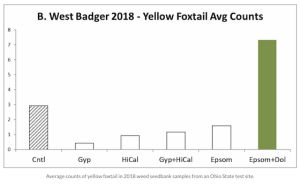Field Study: Soil Balancing – What Ohio State University is learning about Calcium in Soil and Weeds.
Today, we’re looking at two articles written by Matthew Kleinhenz in Eco Farming Daily: “Soil Balancing: Worth Another Look” and “Into the Weeds with Soil Balancing”. In this field study, we are examining some preliminary research performed by the Ohio State University regarding soil structure and observed weeds in an agricultural setting. We’ve talked at length about the value of calcium in soil structure. As such, product recommendations relate specifically to soil test analyses. Soil structure is an integral part of the PJC Healthy Turf Circle and for good reason. Soil structure helps with soil porosity, nutrient availability, and turf durability.
Kleinhenz examines some of the philosophies of Doug Doohan and his book “Weeds-Control Without Poisons”. This book is a favorite of PJC’s president, Fred Newcombe, and is foundational for the philosophies behind organic turf care management. Let’s look at some of the highlights of the article and apply them to organic turf care management.
The graphic below provides a basic representation of Base Saturation as a function of measuring cation exchange capacity. PJC Organic evaluates base saturation in our soil testing service – primarily to get an understanding of soil structure and that a poor Ca:Mg ratio often relates to high weed pressure.

The Benefits of Calcium
In Soil Balancing: Worth Another Look, Kleinhenz states: “The benefits of Ca have been supported by research. Ca helps form bridges between organic and clay surfaces, leading to better soil aggregate stability, while very high Mg levels can reduce pore space and lead to ‘tighter’ soils. Improved soil structure facilitates better drainage, which can mean better seedling establishment, root growth, aeration, and nutrient availability.”
Anecdotally, PJC has seen weed pressure, especially dandelion and plantain, in calcium deficient soils. Almost always, as calcium levels are brought into balance with lime or gypsum, plantain and dandelion presence dramatically decreases. We believe this mostly is a result of a stronger, more porous soil structure that allows turf grass roots to thrive.
While studies have yet to show any financially valuable increase in crop yield through the use of calcium products, they are trending in showing that calcium-based products are in-fact, reducing weed pressure.
This chart from an Ohio State test site counted the weed seedbank of foxtail on control plots, plots treated with magnesium based products and plots treated with calcium based products.

The site treated with magnesium-based, dolomitic lime, in combination with Epsom salt showed over 7.5x the rate of weed seeds of gypsum and more than 2x that of the control plot! While the 3 plots with the least amount of weeds were are all calcium-based products.
The scientific method is an imperfect practice and you should always keep an open mind when interpreting data, but it does a good job of revealing trends and corollary data when tested consistently over time.
Both Kleinhenz and the PJC office would attest that getting soil into balance takes time and effort – but knowing where to start is the key. Contact us for soil testing and find out what’s going on with pH, cation exchange capacity, and base saturation to do your best to reduce weed presence in your lawns.








